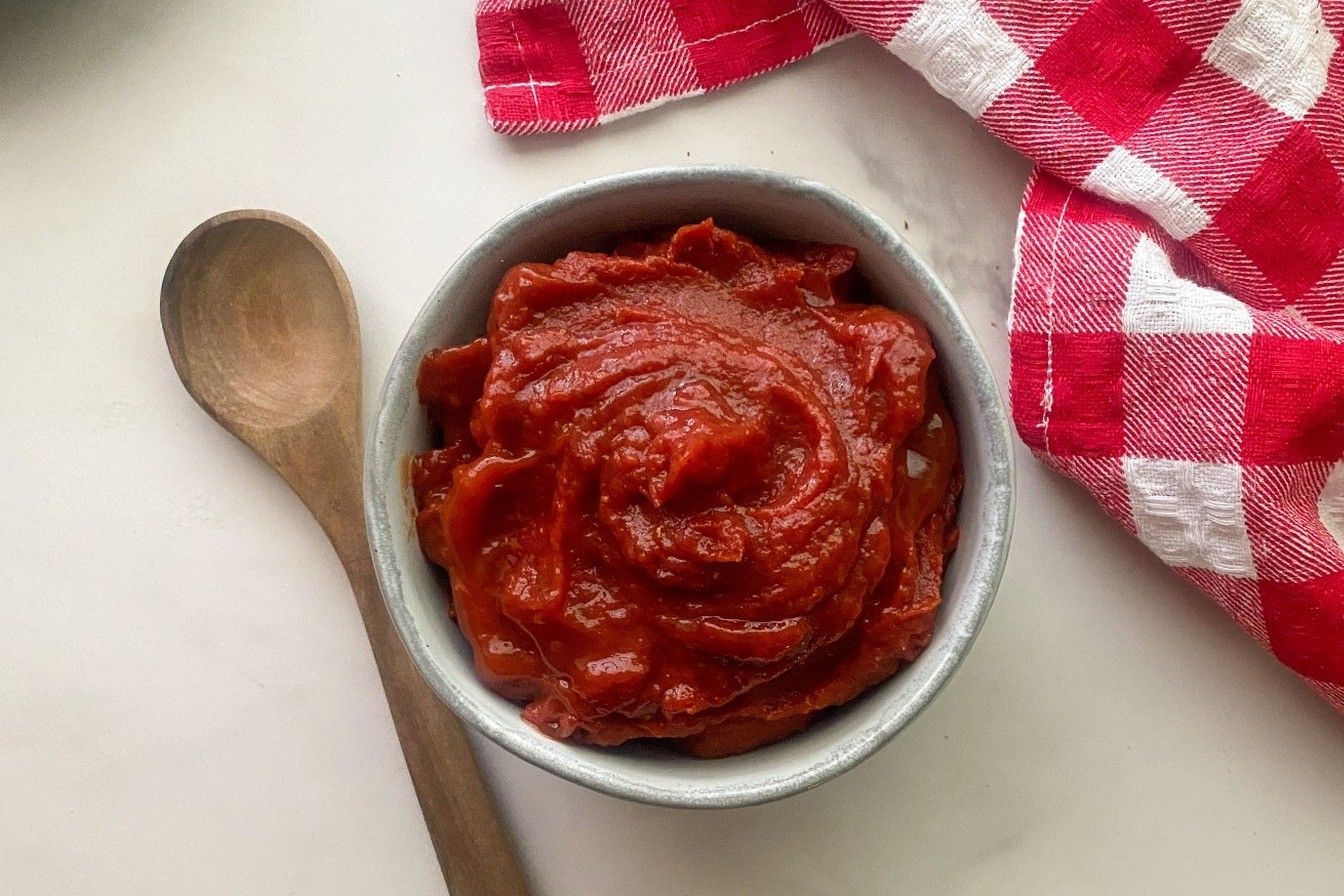Creating your own ketchup at home is a rewarding experience that allows you to control the flavors and ingredients. This homemade version is rich, tangy, and perfectly balanced with a hint of spice. It's a great way to elevate your favorite dishes and impress your family and friends.
Some ingredients in this recipe might not be commonly found in every household. Allspice and cloves are spices that add depth and warmth to the ketchup. If you don't already have these in your pantry, you can find them in the spice aisle of most supermarkets. Apple cider vinegar is another key ingredient that provides acidity and a subtle sweetness; make sure to pick up a bottle if you don't have it at home.

Ingredients For Homemade Ketchup
Tomato paste: The base of the ketchup, providing a rich tomato flavor.
Apple cider vinegar: Adds acidity and a subtle sweetness to balance the flavors.
Brown sugar: Sweetens the ketchup and adds a hint of molasses.
Salt: Enhances the overall flavor.
Onion powder: Adds a mild onion flavor without the texture of fresh onions.
Garlic powder: Provides a subtle garlic flavor.
Allspice: Adds warmth and depth to the ketchup.
Cloves: Contributes a warm, slightly sweet, and aromatic flavor.
Cayenne pepper: Adds a touch of heat.
Water: Helps to achieve the desired consistency.
Technique Tip for This Recipe
To enhance the flavor of your homemade ketchup, consider toasting the allspice and cloves in a dry pan over medium heat for a minute or two before adding them to the mixture. This will release their essential oils and deepen the overall taste.
Suggested Side Dishes
Alternative Ingredients
tomato paste - Substitute with crushed tomatoes: Crushed tomatoes can provide a similar tomato base, though you may need to cook them down to achieve the same thickness.
apple cider vinegar - Substitute with white vinegar: White vinegar has a similar acidity level and can be used in equal amounts, though it lacks the slight sweetness of apple cider vinegar.
brown sugar - Substitute with white sugar: White sugar can be used in the same quantity, but it lacks the molasses flavor found in brown sugar. Adding a small amount of molasses can help mimic the taste.
salt - Substitute with soy sauce: Soy sauce can add a similar salty flavor along with a bit of umami, but be cautious with the quantity to avoid overpowering the ketchup.
onion powder - Substitute with fresh onions: Fresh onions can be finely minced and sautéed to replace onion powder, though the texture will be slightly different.
garlic powder - Substitute with fresh garlic: Fresh garlic can be minced and used in place of garlic powder, providing a more robust garlic flavor.
allspice - Substitute with cinnamon and cloves: A mix of cinnamon and cloves can replicate the warm, spicy flavor of allspice.
cloves - Substitute with nutmeg: Nutmeg can provide a similar warm, spicy note, though it is slightly less intense than cloves.
cayenne pepper - Substitute with paprika: Paprika can add a mild heat and a similar color, though it is less spicy than cayenne pepper.
water - Substitute with vegetable broth: Vegetable broth can add a bit more depth of flavor compared to plain water.
Other Alternative Recipes Similar to This
How to Store or Freeze This Recipe
To store your homemade ketchup, first ensure it has cooled completely to room temperature. This prevents any condensation from forming inside the container, which could dilute the ketchup and affect its flavor.
Transfer the ketchup into a clean, airtight container. Glass jars with tight-fitting lids are ideal, but plastic containers with secure seals will also work. Make sure the container is sterilized to extend the shelf life.
Label the container with the date of preparation. Homemade ketchup can be stored in the refrigerator for up to one month. This way, you can keep track of its freshness and enjoy it at its best.
For longer storage, consider freezing the ketchup. Pour the ketchup into freezer-safe containers or heavy-duty freezer bags. Leave some space at the top of the container or bag to allow for expansion as the ketchup freezes.
If using freezer bags, lay them flat in the freezer to save space and ensure even freezing. Once frozen, you can stack them to maximize freezer space.
When you're ready to use the frozen ketchup, thaw it in the refrigerator overnight. Avoid thawing at room temperature to prevent any bacterial growth.
After thawing, give the ketchup a good stir to reincorporate any separated liquids. The texture might be slightly different from fresh, but the flavor will remain delicious.
If you notice any off smells, colors, or textures, it's best to discard the ketchup. Safety first!
Enjoy your homemade ketchup on burgers, fries, or as a tangy addition to your favorite recipes.
How to Reheat Leftovers
Gently heat the ketchup in a small saucepan over low heat, stirring occasionally until warmed through. This method helps maintain the sauce's consistency and flavor.
Microwave the ketchup in a microwave-safe bowl. Cover it with a microwave-safe lid or plastic wrap with a small vent. Heat on medium power in 15-second intervals, stirring in between, until it reaches the desired temperature.
Place the ketchup in a heatproof bowl and set it over a pot of simmering water (double boiler method). Stir occasionally until it is heated evenly. This gentle method prevents scorching and preserves the sauce's texture.
If you have a sous vide machine, seal the ketchup in a vacuum-sealed bag and immerse it in a water bath set to 140°F (60°C). Heat for about 15-20 minutes, ensuring the sauce is evenly warmed without altering its consistency.
Best Tools for This Recipe
Saucepan: A medium-sized saucepan is essential for combining and cooking the ingredients over medium heat.
Wooden spoon: Use a wooden spoon to stir the mixture occasionally while it simmers and cooks.
Blender: A blender is needed to blend the mixture until smooth after cooking.
Sieve: A sieve is used to strain the blended mixture to remove any solids, ensuring a smooth ketchup.
Sealed container: Store the finished ketchup in a sealed container to keep it fresh in the fridge.
Measuring cups: Use measuring cups to accurately measure the tomato paste, apple cider vinegar, brown sugar, and water.
Measuring spoons: Measuring spoons are necessary for measuring the salt, onion powder, garlic powder, allspice, cloves, and cayenne pepper.
How to Save Time on Making This Recipe
Use pre-made tomato paste: Opt for store-bought tomato paste to skip the lengthy process of making it from scratch.
Measure ingredients in advance: Pre-measure all ingredients and have them ready to go before you start cooking.
Simmer with a lid: Cover the saucepan with a lid to speed up the simmering process and prevent splatters.
Use an immersion blender: Blend the mixture directly in the saucepan with an immersion blender to save time on transferring and cleaning.
Skip the sieve: If you don't mind a slightly chunkier texture, skip the sieving step.
Ketchup Recipe
Ingredients
Main Ingredients
- 2 cups Tomato paste
- ½ cup Apple cider vinegar
- ½ cup Brown sugar
- 1 teaspoon Salt
- ½ teaspoon Onion powder
- ½ teaspoon Garlic powder
- ¼ teaspoon Allspice
- ¼ teaspoon Cloves
- ¼ teaspoon Cayenne pepper
- 1 cup Water
Instructions
- Combine all ingredients in a saucepan over medium heat.
- Bring to a simmer, then reduce heat to low.
- Cook, stirring occasionally, for 30 minutes.
- Blend the mixture until smooth.
- Strain through a sieve to remove any solids.
- Let cool and store in a sealed container in the fridge.
Nutritional Value
Keywords
More Amazing Recipes to Try 🙂
- Birria Quesa Tacos Recipe3 Hours 30 Minutes
- Peruvian Chicha Morada Drink Recipe55 Minutes
- Linguine with Clam Sauce Recipe35 Minutes
- Sausage Stuffed Jalapenos Recipe35 Minutes
- Cowboy Caviar Recipe15 Minutes
- Ground Beef and Potatoes Recipe40 Minutes
- Turkey Avocado Panini Recipe15 Minutes
- Chicken Wing Dip Recipe30 Minutes

Leave a Reply